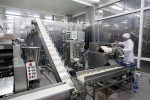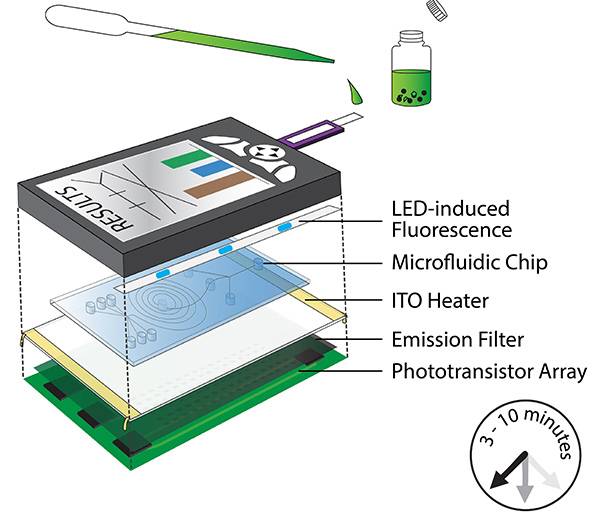Undeclared allergens continue to be a big cause of food recalls. For allergen management practices to be effective within food companies, there must be a shared responsibility between food manufacturers, government agencies, regulators and consumers, says Guangtao Zhang, Ph.D., director of the Mars Global Food Safety Center. In a Q&A with Food Safety Tech, Zhang discussed key concerns related to undeclared allergens in food as well as the research that Mars is conducting to improve allergen management.
Food Safety Tech: The presence of undeclared allergens continues to be a hazard in the food safety space. Specific to peanut detection, what challenges is the industry facing?

Guangtao Zhang, Ph.D.: As food materials become more varied and complicated, food allergen management becomes increasingly complex. Robust, accurate and sensitive detection methods are essential to ensure consumer safety as well as compliance with regulatory standards for allergens in the food supply chain.
When you look at the regulatory aspects, detection methods go hand in hand. Firstly, there is a need to ensure that current standard detection methods used in regulatory control of consumer goods are validated for a range of complex food matrices to ensure neither over- nor under-estimation of allergen content occurs within a food supply chain. This is important because underestimation of allergen poses a significant food safety hazard to consumers, while overestimation of allergen can result in unnecessary product recalls, driving up product costs and food waste.
Secondly, validation and monitoring of the effectiveness of cleaning and handling practices in areas of potential cross contamination with allergen containing materials depend on reliable and robust quantitative food allergen test methods for their success. The more robust the testing protocols, the more we can improve our understanding of the risks associated with cross contamination of food allergens, potentially reducing the frequency of accidental contamination events.
It is also important to note that whilst the most common cause of undeclared allergen in the global food supply chain is through accidental contamination in raw materials or finished products, this is not the only method by which undeclared allergen may be found in a product.
For example, peanut flour may be used in economically motivated adulteration (EMA) food fraud cases. In 2018 the European Commission estimated that the cost of food fraud for the global food industry is approximately €30 billion every year. Due to its high protein content, peanut flour has been used as a bulking agent to raise the overall protein content of e.g., wheat flour, thus raising the ‘quality’, and therefore price, of lower value goods. The ability to effectively quantify peanut traces within complex products therefore has the potential to enable consumers of food products to further trust the safety of the food they eat.
ELISA (Enzyme linked immunosorbent assay) is the method used most frequently for peanut allergen detection in the food manufacturing industry because of its sensitivity and ease of use. However, it has disadvantages in certain settings. It is not currently validated for complex food matrices, as it is believed that the effects of both food matrices and food processing could result in an underestimation of peanut concentrations in thermally processed foods, leading to false negatives, as well as overestimation in complex food matrices, leading to false positives which are a potential food safety hazard to consumers.
Food Safety Tech: Tell us about the research that the Mars Global Food Safety Center is doing to help the industry with effective methods for peanut quantification.
Zhang: At the Mars Global Food Safety Center (GFSC) we believe that everyone has the right to safe food and that we have a responsibility to generate and share insights to help solve for global food safety challenges. We also know we can’t tackle these alone, which is why we collaborate with external partners. One of our focus areas is advancing understanding and knowledge sharing in peanut allergen detection. As part of that work, we are exploring methods of improving food safety via the development of advanced analytical methods to detect peanut allergen content, in the hopes that it will enable the food industry to expand on current preventative management protocols, including early detection methodologies, for faster response to future food allergen contamination events.
As part of our latest published research, we investigated the accuracy and sensitivity of ELISA-based test methods on raw and cooked wheat flour, wheat flour-salt and wheat flour-salt-oil matrices, which are common ingredients in the food industry. 10 ppm peanut was doped into each matrix during sample preparation. Recovery testing demonstrated that in all matrices the current industry standard ELISA method overestimated results with recoveries ranging from 49.6 to 68.6 ppm.
These findings prompted the development of a new confirmatory method based on liquid chromatography-tandem mass spectrometry (HPLC-MS/MS) for peanut quantification. When subjected to the same validation testing programme the HPLC-MS/MS technique was demonstrably more accurate and sensitive, with a limit of quantification of 0.3 ppm and the detected peanut concentration ranging from 6.8 to 12.8 ppm for samples doped with 10 ppm peanut.
This work is a first step in the development of a new standard method for peanut detection in complex food matrices and could ultimately inform safer manufacturing Quality & Food Safety (Q&FS) processes across global supply chains to help ensure safe food for all.

Food Safety Tech: What projects are researchers at the Center working on to enhance allergen management as a whole?
Zhang: A successful allergen management program depends on rigorous control of allergenic foods and ingredients from all other products and ingredients at every step of the food production process, from raw material development to the delivery of final products. This means that for allergen management practices to be effective, they must be a shared responsibility between food manufacturers, government agencies, regulators and consumers.
At the Mars GFSC, we take a precompetitive approach to research, knowledge sharing and collaborations—this means we openly share insights and expertise to help ensure safe food for all. This is important in driving forward innovations, helping unlock solutions that may not have previously been possible.
We have shared our latest work both through an open access publication in Food Additives & Contaminants: Part A but also directly with regulatory bodies such as the FDA in the hopes of advancing knowledge in both food safety risk management and allergen management in complex flour-based media within global supply chains. In addition to this, this research contributes to a wider Food Safety Best Practice whitepaper focused on food allergen risk management currently under draft by the Mars GFSC, which will be published in collaboration with Walmart Food Safety Collaboration Center and the Chinese Institute of Food Science and Technology (CIFST) later this year.
We believe that global collaborations such as this are essential to improving food allergen management and mitigating food safety risks. Communication, training and knowledge sharing are core principles of the Mars GFSC and as such form a large part of our ongoing activities in this space. For example, we have hosted Food Allergen Management workshops in collaboration with Danone and Romer Labs focused on helping to raise awareness of current and future food allergen trends. At one such event in 2019, 100 participants from 16 food companies came together to promote food allergen management in the industry and ensure that the next generation of food integrity testing capability is relevant, practical, and directly applicable to the real-world problems experienced by manufacturers and processors throughout the supply chain.
Representatives of the Mars GFSC have also shared our insights externally at a number of international conferences as well as during a Food Enterprise Food Allergen Management Seminar on topics including effective allergen management procedures, our guiding principles for allergen managements at Mars, and shared our approach to encourage and share knowledge with other manufactures in this area.
We continue to support requests for technical insights, for example providing insights during a global consultation session on General Principles for Labeling of Prepackaged Food. This resulted in the addition of characterization requirements for possible allergenic substances, promoting the use of a recognizable naming system in ingredient lists that contain allergen warnings.
Food Safety Tech: Can you comment on additional work your team is doing in the area of food fraud?
Zhang: Food allergen risk management forms only one part of our wider food integrity focus at the Mars GFSC. We are committed to helping ensure food authenticity in an increasingly complex, global food supply chain through collaboration with global partners to develop new and improved tools and analytical methods that help protect the integrity of raw materials and finished products.
We have collaborated with researchers at Michigan State University to develop a Food Fraud Prevention Cycle roadmap (Introducing the Food Fraud Prevention Cycle (FFPC): A dynamic information management and strategic roadmap) which answered questions such as how to detect food fraud, how to start a food fraud prevention program, what to do in terms of testing, how much testing is enough, and how to measure success. Our intention in publishing this research was that the adoption of a holistic and all-encompassing information management cycle will enable a globally harmonized approach and the continued sharing of best practices across industry partners.
More recently, we completed an international collaboration tackling rice adulteration together with Queen’s University Belfast (QUB), Agilent Technologies, International Atomic Energy Agency (IAEA), China National Center for Food Safety Risk Assessment (CFSA), and Zhejiang Yangtze Delta Institute of Tsinghua University (Yangtze Delta). This work successfully developed a two-tier testing program, capable of rapidly screening the geographical origins of rice within the global supply chain (Food Fingerprinting: Using a two-tiered approach to monitor and mitigate food fraud in rice). By developing a tiered system, we could ensure that manufacturers use the right techniques for the right occasion, to maximize the information available in investigating food fraud at the best value. As part of this work, we have helped develop hands-on training in Ghana and inform best practice guidance to help build the foundations of a strong food safety culture in rice authenticity across the global supply chain.

















